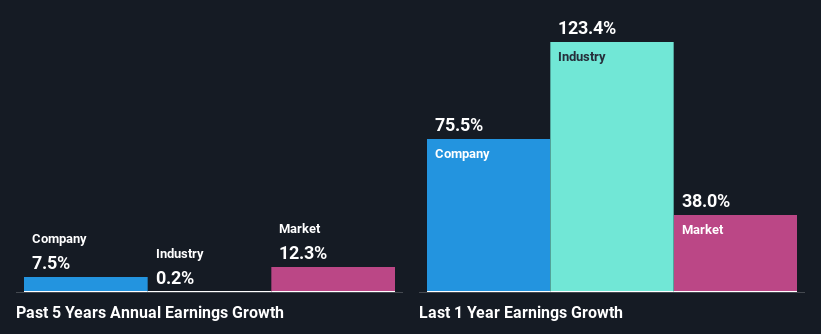BorgWarner Inc.'s (NYSE:BWA) Fundamentals Look Pretty Strong: Could The Market Be Wrong About The Stock?
BorgWarner (NYSE:BWA) has had a rough three months with its share price down 16%. However, a closer look at its sound financials might cause you to think again. Given that fundamentals usually drive long-term market outcomes, the company is worth looking at. Particularly, we will be paying attention to BorgWarner's ROE today.
Return on Equity or ROE is a test of how effectively a company is growing its value and managing investors’ money. Put another way, it reveals the company's success at turning shareholder investments into profits.
View our latest analysis for BorgWarner
How Is ROE Calculated?
Return on equity can be calculated by using the formula:
Return on Equity = Net Profit (from continuing operations) ÷ Shareholders' Equity
So, based on the above formula, the ROE for BorgWarner is:
13% = US$882m ÷ US$7.0b (Based on the trailing twelve months to June 2021).
The 'return' refers to a company's earnings over the last year. Another way to think of that is that for every $1 worth of equity, the company was able to earn $0.13 in profit.
Why Is ROE Important For Earnings Growth?
Thus far, we have learned that ROE measures how efficiently a company is generating its profits. Based on how much of its profits the company chooses to reinvest or "retain", we are then able to evaluate a company's future ability to generate profits. Assuming everything else remains unchanged, the higher the ROE and profit retention, the higher the growth rate of a company compared to companies that don't necessarily bear these characteristics.
BorgWarner's Earnings Growth And 13% ROE
At first glance, BorgWarner seems to have a decent ROE. And on comparing with the industry, we found that the the average industry ROE is similar at 14%. This probably goes some way in explaining BorgWarner's moderate 7.5% growth over the past five years amongst other factors.
We then compared BorgWarner's net income growth with the industry and we're pleased to see that the company's growth figure is higher when compared with the industry which has a growth rate of 0.2% in the same period.
The basis for attaching value to a company is, to a great extent, tied to its earnings growth. The investor should try to establish if the expected growth or decline in earnings, whichever the case may be, is priced in. Doing so will help them establish if the stock's future looks promising or ominous. What is BWA worth today? The intrinsic value infographic in our free research report helps visualize whether BWA is currently mispriced by the market.
Is BorgWarner Making Efficient Use Of Its Profits?
In BorgWarner's case, its respectable earnings growth can probably be explained by its low three-year median payout ratio of 20% (or a retention ratio of 80%), which suggests that the company is investing most of its profits to grow its business.
Moreover, BorgWarner is determined to keep sharing its profits with shareholders which we infer from its long history of eight years of paying a dividend. Our latest analyst data shows that the future payout ratio of the company is expected to drop to 12% over the next three years. As a result, the expected drop in BorgWarner's payout ratio explains the anticipated rise in the company's future ROE to 16%, over the same period.
Summary
In total, we are pretty happy with BorgWarner's performance. In particular, it's great to see that the company is investing heavily into its business and along with a high rate of return, that has resulted in a sizeable growth in its earnings. That being so, the latest analyst forecasts show that the company will continue to see an expansion in its earnings. To know more about the company's future earnings growth forecasts take a look at this free report on analyst forecasts for the company to find out more.
This article by Simply Wall St is general in nature. We provide commentary based on historical data and analyst forecasts only using an unbiased methodology and our articles are not intended to be financial advice. It does not constitute a recommendation to buy or sell any stock, and does not take account of your objectives, or your financial situation. We aim to bring you long-term focused analysis driven by fundamental data. Note that our analysis may not factor in the latest price-sensitive company announcements or qualitative material. Simply Wall St has no position in any stocks mentioned.
Have feedback on this article? Concerned about the content? Get in touch with us directly. Alternatively, email editorial-team (at) simplywallst.com.

 Yahoo Finance
Yahoo Finance 
